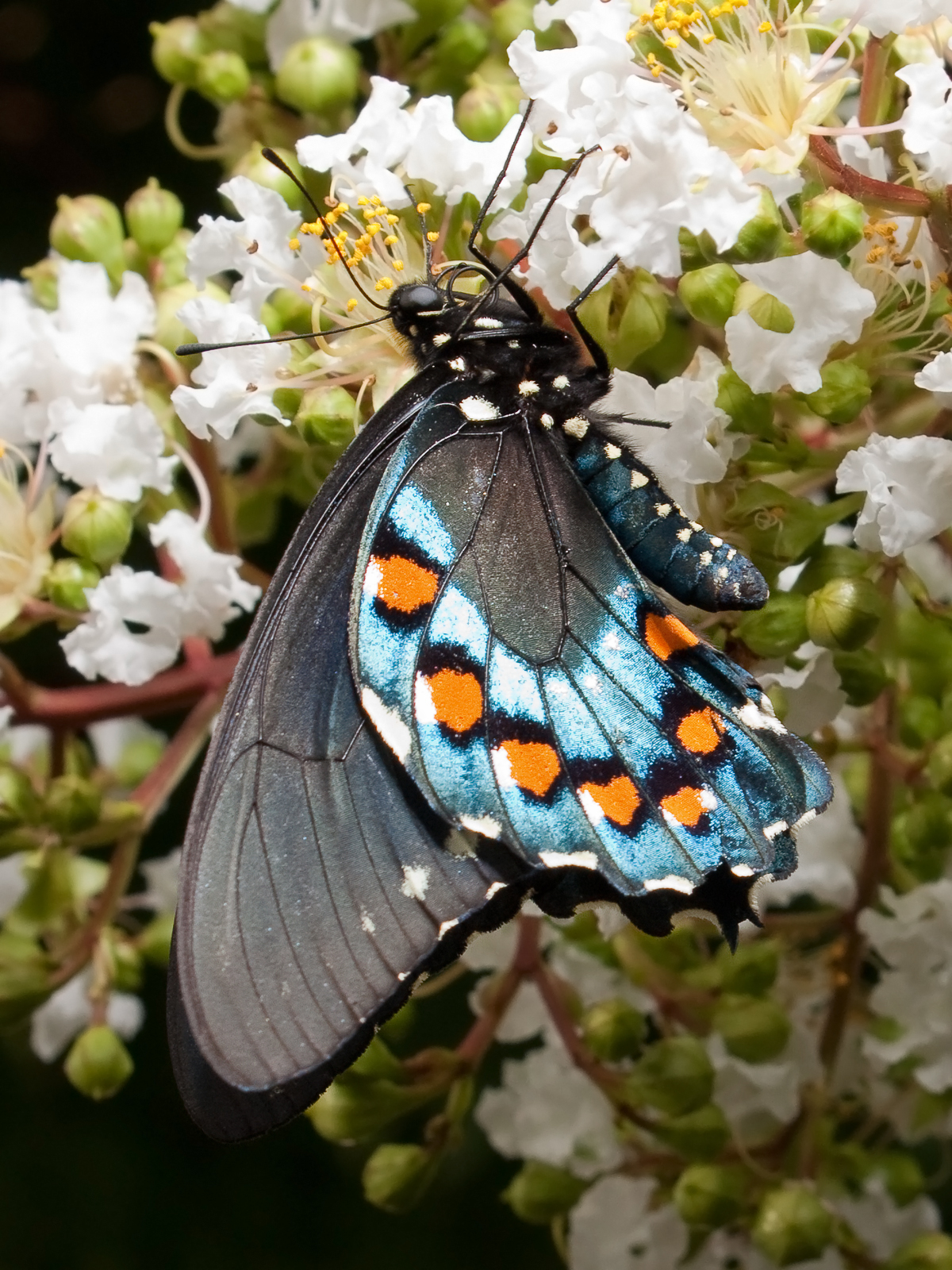看起來很警戒,身上的顏色就都很警戒?重新評估北美經典擬態模型的警戒色的例子
photo from Battus philenor (wiki)
標題:Warning Signal Efficacy: Assessing the Effects of Color, Iridescence, and Time of Day in the Field
摘要
Warning coloration deters predators from attacking distasteful or toxic prey. Signal features that influence warning color effectiveness are not well understood, and in particular, we know very little about how effective short-wavelength and iridescent colors are as warning color elements in nature and how warning signal effectiveness changes throughout the day. We tested the effect of these factors on predation risk in nature using specimens of the distasteful pipevine swallowtail butterfly, Battus philenor. B. philenor adults display both iridescent blue and diffusely reflecting orange components in their warning signal. We painted B. philenor wings to create five different model types: all-black, only-iridescent-blue, only- orange, iridescent-blue-and-orange (intact signal), and matte-blue-and- orange. We placed 25 models in each of 14 replicate field sites for 72 h and checked for attacks three times each day. Model type affected the likelihood of attack; only-orange models were, the only model attacked significantly less than the all-black model. Iridescence did not enhance or decrease warning signal effectiveness in our experiment because matte- blue-and-orange models were attacked at the same rate as iridescent- blue-and-orange models. Time of day did not differentially affect model type. Video recordings of attacks revealed that insectivorous birds were responsible. The results of this experiment, when taken with previous work, indicate that the response to blue warning coloration is likely dependent on predator experience and context, but that iridescence per se does not affect warning signals in a natural context.
在讀行為學、生態學或是普通生物學的時候,念到擬態的部分會搭配一個很典型的例子,然後就會自然而然很少懷疑這些百年前的科學前所指定的擬態群,牠們的警戒訊號到底有沒有發揮作用。或是有時候會認知一個物種身上所有的斑紋,都對警戒訊號有貢獻,特別是那些有金屬色的物種們。
這個研究就在嘗試解決這個疑慮。Pipevine swallowtail (Battus philenor) 是一種廣泛分佈在北美洲的鳳蝶,幼生期的寄主植物就如俗名,是取食馬兜鈴類的植物,這種植物含有高量植物鹼,幼蟲取食後會儲存在體內,成體時會透過某種機制,像是被攻擊的時候ˇ噴放臭氣來抵抗捕食者,因此這個鳳蝶被認為是北美的線蛺蝶(Limenitis arthemis)與 大黃鳳蝶 (Papilio glaucus)雌性的擬態模型。這個鳳蝶的腹面有幾個明顯的大橘斑,還有閃亮的金屬藍色,而金屬色對於人類來說十分閃亮,甚至有可能反射人類看不到的偏極光或紫外光,而且金屬色在許多涉入擬態的物種都存在,只是之前的研究預設這樣顯眼的顏色必然對於警戒色有貢獻,那麼究竟有沒有在人類的感官之外的故事呢?
作者嘗試的用顏料操作斑紋,把斑紋塗成四種樣式:全黑、只有金屬藍、只有橘斑、無金屬的藍色+橘斑,加上一個對照組,然後把處理過的樣本放到野外,看看哪個部分對於警戒色有貢獻,以及記錄一天內不同的時間對於這些模型的攻擊率的差異。結果顯示會來攻擊的是食蟲性的鳥類,紅橘斑毫無疑問的是一個很重要的訊號,但金屬藍在處理間卻沒有任何的差異,也就是這個金屬色並未影響警戒訊號的有效性。一天內不同的時間對於被攻擊率沒有差異。
雖然沒有預想中的功用,但動物的體色也可能在性擇求偶這方面有所用處。也有很多其他區域的擬態群,牠們的金屬色也還沒被檢測過,雖然有的看起來就像這個例子,與擬態明顯的相關,這讓我們對於警戒色與擬態的功用有更多探索的空間,也提醒我們很多早期的自然學家體認的擬態群,他們想像中的故事可能跟自然界實際發生的劇情可能有很大的落差。






0 comments